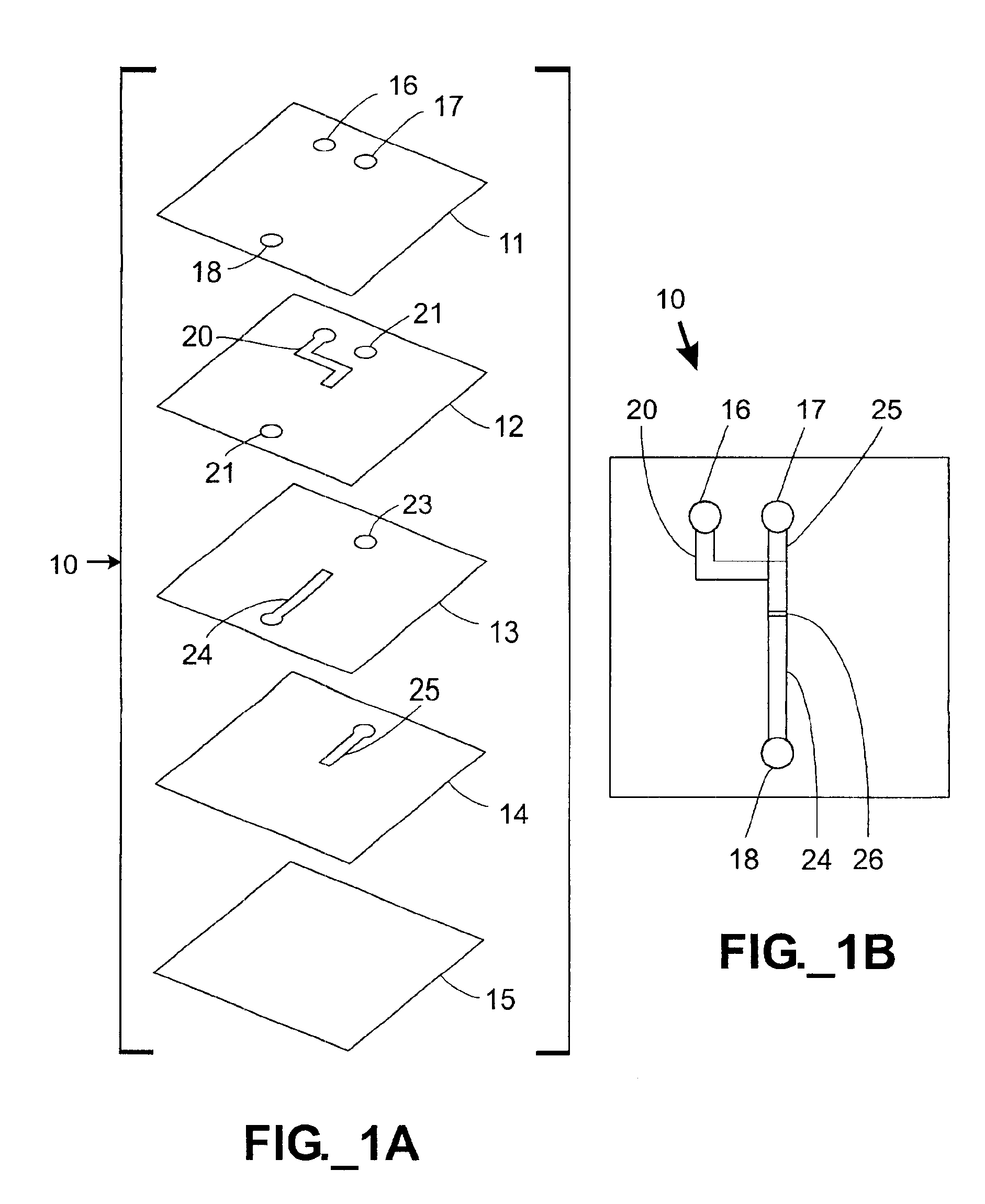Multi-stream microfluidic aperture mixers
a microfluidic and mixer technology, applied in the field of mixing and of fluids in microfluidic systems, can solve the problems of high tool-up cost of such techniques, complicated biochemical reactions and processes, and inability to quickly prototyping and manufacture flexibility
- Summary
- Abstract
- Description
- Claims
- Application Information
AI Technical Summary
Benefits of technology
Problems solved by technology
Method used
Image
Examples
example 1
[0085]In this example, the mixing characteristics of various microfluidic mixers according to conventional designs are compared against one microfluidic mixer according to the present invention. Referring to FIGS. 3A-3B, a single device 60 containing four independent microfluidic mixers 90-93 was constructed. The device 60 was constructed from five layers 61-65 (including sandwiched stencil layers 62-64) to demonstrate the novel overlap mixer 90, but the mixers 91-93 approximated conventional 2-dimensional surface micromachined mixers. Applicants are not aware of the construction of conventional mixers such as those illustrated (e.g., mixers 91-93) by others using a sandwiched stencil construction method. The first layer 61 served as a cover layer, defining fluidic inlet ports 66, 67 and outlet ports 70, 71 for each of the three conventional-type mixers 91-93, further defining inlet ports 68, 69 and outlet ports for the novel overlap mixer 90. The second layer 62 defined channels 74...
example 2
[0092]In one embodiment of the present invention, more than two fluids may be mixed in a single overlap region. For example, FIGS. 5A-5B illustrate a microfluidic mixing device 100 that receives and mixes three different fluid streams. The mixing device 100 is constructed in seven layers 101-107, including stencil layers 102, 104, 106. The first layer 101 defines three fluid inlet ports 108-110 and a single fluid outlet port 112. The second layer 102 defines a first fluid inlet channel 114 and vias 115, 116, 118. The third layer 103 defines three vias 119-121 and a first wide (large) slit 122. The fourth layer 104 defines one via 125 and an inlet / outlet channel 124. The fifth layer 105 defines a via 126 and a second wide slit 127. The sixth layer 106 defines a third fluid inlet channel 128. The seventh layer 107 is a bare substrate that serves as the lower boundary of the channel 128 and serves to support the device 100. All of the channels have a nominal width of about sixty (60) m...
example 3
[0094]In one embodiment, multiple fluid input streams may be simultaneously mixed in different proportions to yield a greater number of output streams. For example, a microfluidic multi-mixing device 140 is shown in FIGS. 6A-6B. This mixing device 140 receives two different fluids as inputs and is capable of providing four different fluid streams as outputs. The device 140 is constructed from five layers 141-145, including stencil layers 142-144. The first layer 141 defines two inlet ports 152, 153 and four outlet ports 154-157. The second layer 142 defines vias 158, 159 and five channel segments 160 having rounded portions. The third layer 143 defines two forked inlet channels 162, three intermediate splitting channels 163, and four outlet channels 164. The fourth layer 144 defines five more channel segments 165 having rounded portions. The fifth layer 145 is a bare substrate that encloses the channel segments 165 from below and provides support for the device 140. The forked inlet...
PUM
 Login to View More
Login to View More Abstract
Description
Claims
Application Information
 Login to View More
Login to View More - R&D
- Intellectual Property
- Life Sciences
- Materials
- Tech Scout
- Unparalleled Data Quality
- Higher Quality Content
- 60% Fewer Hallucinations
Browse by: Latest US Patents, China's latest patents, Technical Efficacy Thesaurus, Application Domain, Technology Topic, Popular Technical Reports.
© 2025 PatSnap. All rights reserved.Legal|Privacy policy|Modern Slavery Act Transparency Statement|Sitemap|About US| Contact US: help@patsnap.com



